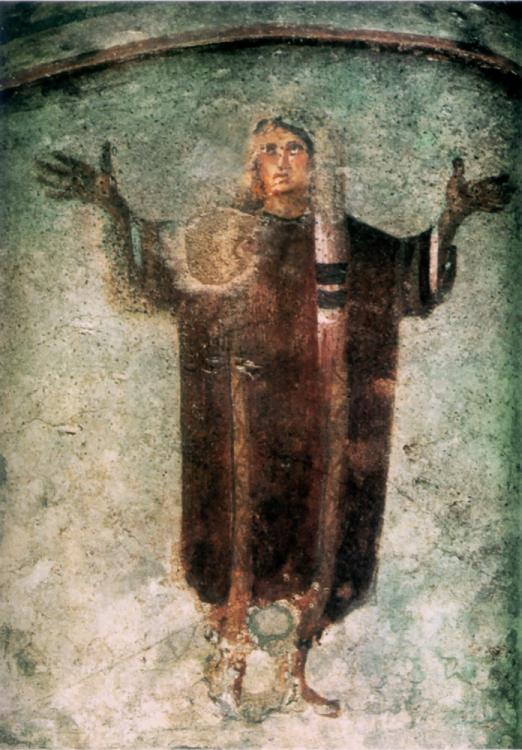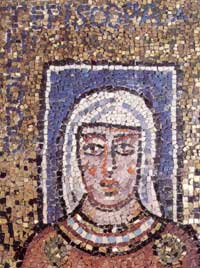The historiographical problem
The New Testament suggests that women generally gave considerable leadership in the early Christian movement, but by the fourth century their role seems to have become much more restricted. Or were women more influential in early Christianity than we've realized? What roles did women really play in the early Church? Have we been misled by the spotty surviving evidence generally written by men, many of them celibate? Can we find other evidence, or can we read the evidence that we do have in a creative and discerning and perhaps suspicious way?
From the New Testament to Constantine

In the New Testament, women are seen to be exercising ministries of prophecy, diaconia, apostolate, hospitality (as hosts of housechurches), evangelism, teaching, and so on. Here (linked) is what appears to be an exhaustive list of women in the New Testament. There are few hints of restrictions on women in practice even in the second century, as we see from the cases of Blandina and Perpetua. And from the third century, here's a fresco from the Greek chapel of the Catacomb of Priscilla under Rome: some interpret it as showing a woman in orans (praying) position, like the presider at a Eucharist.
Nevertheless, there are texts in the New Testament itself and later that appear to discourage the ministry of women. For a historian, such texts function as evidence in favour of the reality of the ministry of women, since people wouldn't object to it if it weren't happening.
Restrictions on the ministry of women appear in [Hippolytus'?] Apostolic Tradition. As we saw on webpage #10, this text used to be dated to around CE 215, but now it's seen as a work compiled much later.
After Constantine
We know the names of a number of influential Christian women from the fourth and later centuries, and a little about them. They include:
- Lucilla (early 300s);
- Marcella (325–411),
- Melania the Elder (342–400),
- Macrina the Elder (d. c. 340),
- Macrina the Younger (330–379),
- Egeria (or Aetheria), a Spanish nun of the 380s, whose diary of her trip to the Holy Land is one of the few documents by a women to survive (in part) from the early Church;
- Paula of Rome (347–404),
- Melania the Younger (d. 439),
- Olympias (360–408), and
- Brigid (d. 525).
Macrina the Younger is perhaps especially significant as a theologian and saint who influenced her better known brothers, Basil the Great and Gregory of Nyssa. Gregory's Life of Macrina pictures her as extraordinarily wise, profound, and devout.
 Here is a picture of part of a ninth-century mosaic in the Zeno chapel of the Roman basilica of Saints Pudentiana and Praxedis. Some believe that it shows a female bishop, Theodora.
Here is a picture of part of a ninth-century mosaic in the Zeno chapel of the Roman basilica of Saints Pudentiana and Praxedis. Some believe that it shows a female bishop, Theodora.
Why is the role of women so restricted in the centuries after the legalization of Christianity? Various explanations have been offered for this development. Here are some of them.
- The Church became increasingly inculturated as it became more socially important, and consequently the gender prejudices of Greco-Roman society came to be imported into Christianity. For example, widows played a more prominent role of leadership in the Church than married women and dependent daughters, and that situation reflected Roman society. See Charlotte Methuen in Harvard Theological Review, 1997, and Theology, 2005. .
- New Testament house churches were "private" institutions, like families, but in time they became "public" institutions. In families, women then as now played quite a large role, and when a predominant metaphor for the Church was "family of God", it was natural for women to be prominent. But when the Church became a public institution, it may have seemed more culturally appropriate for leadership to be restricted to men. This is the thesis of Karen Jo Torjesen in her book When Women Were Priests.
- The rise of asceticism in the late third century privileged male celibates. Ascetic theology tended to regard sexuality as problematic, and also tended to associate women more closely with sexuality than men. If this is so, it's not only women, but also married men who began losing their influence in Church affairs. What was happening was not so much the subordination of women in particular, as the exaltation of celibate gentile men.
- Trends in Scriptural interpretation had a major influence. In particular, the story of Adam and Eve becomes quite important in the third century to explain human sin and unhappiness, and one reading of that story was that the original sin was the fault of the woman.